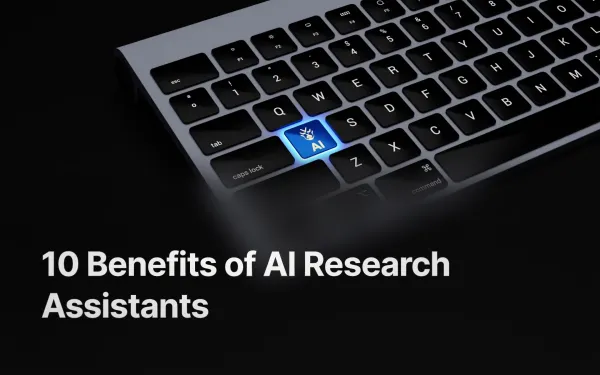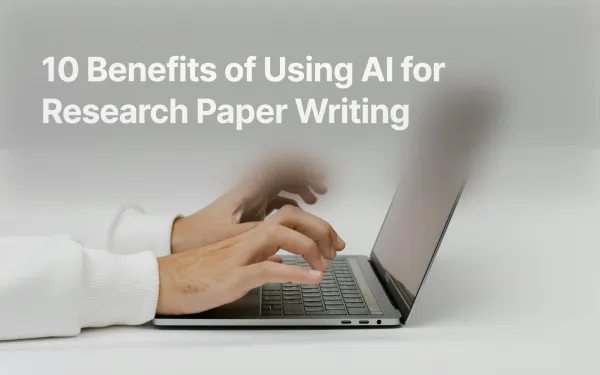What is an AI Brief Generator: Features, Benefits, and More
Discover the features, benefits, and more of AI brief generators, transforming how you create concise, effective, and insightful briefs effortlessly.

Have you ever wished for a faster way to create content or simplify complex information?
In this blog post, we'll explain what an AI Brief Generator is, look at its main features, explore its benefits, and more.
Whether you're a busy professional, a content creator, or simply curious about the latest in AI technology, learning about AI Brief Generators can make a big difference. Let's dive into how this tool can help you create better content quickly and easily.
Definition of AI Brief Generators
AI Brief Generators are tools designed to help you save time and effort by quickly summarizing long documents, articles, or any large amount of text.
These tools use artificial intelligence to understand and pick out the most important points from the text. This means you can get a quick overview or a brief summary without needing to read through everything.
They're especially useful when you need to understand a lot of information quickly, like for research, studying, or staying up-to-date with news or reports.
Core Technologies Behind AI Brief Generators

AI Brief Generators rely on some advanced technologies to work effectively.
Here's a simple breakdown of the core technologies behind these tools:
1. Natural Language Processing (NLP)
This technology helps computers understand and process human language. Just like humans can interpret words and sentences, NLP allows AI to read text, grasp its meaning, and even generate new text that sounds natural.
2. Machine Learning Models
These are like the brain of the AI, where the computer learns from lots of data how to perform tasks, such as summarizing text. The more it learns, the better it gets at predicting and generating accurate summaries.
3. Neural Networks
Imagine a huge network of interconnected points, similar to how neurons in the human brain are linked. Neural networks are a series of algorithms that attempt to recognize underlying relationships in a set of data through a process that mimics the way the human brain operates.
This structure helps the AI understand complex patterns and make decisions based on them, enhancing its ability to generate briefs that are clear and relevant.
The Process of Text Summarization
Text summarization is a useful process that AI Brief Generators use to create short and clear summaries of longer texts.
Here's a simple explanation of how it works and why it's important:
a. Reading and Understanding
First, the AI reads through the entire text, just like how you would. It uses Natural Language Processing (NLP) to understand the content as a human would, recognizing key points and themes.
b. Identifying Key Points
After understanding the text, the AI picks out the most important points. These are the bits of information that are crucial for understanding the overall message or story.
c. Condensing Information
The AI then uses what it has learned to condense these key points into a shorter form. It keeps the essential information but removes less important details and filler words.
d. Generating the Summary
Finally, the AI puts together the condensed key points into a coherent summary that flows well and is easy to read.
Role of Text Summarization in Brief Generators

Text summarization is vital in brief generators because it allows these tools to quickly provide you with the essence of long documents or articles. This is especially helpful when you need to gather information quickly or when you're dealing with a large volume of content.
By getting a summary, you can decide whether you need to read the full document or if the summary has given you enough information. This saves time and makes it easier to stay informed or make decisions based on large amounts of text.
Data Handling for AI Brief Generation

Data handling is an important step in AI Brief Generation, involving several processes that prepare and analyze the text data to make it usable for creating summaries.
Let's break down these processes into simpler terms and provide examples for better understanding:
1. Data Preprocessing
Data preprocessing is about getting the data ready before the AI can analyze it. This step ensures that the text is clean and uniform, which helps the AI understand and process it better.
Examples of Data Preprocessing:
- Removing Special Characters and Numbers: If the text includes symbols or numbers that aren’t necessary for understanding the main content, the AI removes them. For example, if the text has email addresses, phone numbers, or web links, these may be stripped out to focus purely on the informational content.
- Correcting Typos and Grammar: The AI can correct simple spelling mistakes or grammatical errors to ensure the text is accurate. This helps in avoiding misunderstandings of the text's meaning.
- Converting Text to Lowercase: This is done to make sure that all the words are treated the same way by the AI, regardless of whether they appear at the start of a sentence or in names. For instance, "Apple" and "apple" would be considered the same.
2. Feature Extraction
Feature extraction is about identifying and pulling out specific features from the text that are important for summarization. These features help the AI determine which parts of the text are key points.
Examples of Feature Extraction:
- Keyword Identification: The AI looks for words that are repeated often or have high importance in the context. For example, in a document about climate change, words like "emissions," "global warming," and "sustainability" might be identified as key features.
- Identifying Themes: The AI analyzes the text to find common themes or topics. For instance, in an article that discusses technology, themes such as "AI," "innovation," and "software development" might emerge.
- Sentiment Analysis: This involves determining the tone of the text. For a product review, the AI might identify positive, neutral, or negative sentiments based on the words used, helping to summarize the overall opinion in the text.
Deep Dive into Semantic Analysis
Semantic analysis is a deep and complex process used by AI to understand the meaning behind words and phrases in a text, rather than just looking at the words themselves.
Here’s a simpler explanation of what it involves and how it enhances the accuracy of content:
1. Understanding Semantic Analysis
Semantic analysis helps AI grasp the context and the nuances of language in the text. It looks at how words and phrases relate to each other, considering things like irony, jokes, or cultural references to interpret the true meaning.
For example:
- Context Recognition: If the sentence is "I am blue," semantic analysis helps determine whether "blue" refers to feeling sad or actually being the color blue, based on the context of the conversation or text around it.
- Synonym Handling: It recognizes that words like "happy," "joyful," and "glad" broadly mean the same thing, even though they are different words.
2. Semantic Analysis on impact on content accuracy
By understanding the deeper meanings of text, semantic analysis significantly improves the accuracy of the content brief that AI generates or summarizes.
Here's how semantic analysis impacts content accuracy:
- Better Summaries: By understanding the context and nuances, AI can create summaries that are more accurate and reflective of the original text's intent. This is crucial when dealing with complex topics that require an understanding of subtle cues and differences in meaning.
- Accurate Interpretations: In fields like law or medicine where every word can have significant implications, semantic analysis ensures that the AI does not misinterpret meanings, which could lead to misleading or incorrect information.
- Cultural and Linguistic Nuance: Semantic analysis allows AI to understand cultural idioms or expressions specific to particular languages, which might be lost in simple word-to-word translation or summarization. This is especially important in global communications.
Learning Approaches of AI Brief Generator

a. Supervised Learning
In supervised learning, the AI Brief Generator is trained on a dataset that includes both the input texts and their correct summaries. The training process involves teaching the AI to predict or generate a summary that matches the provided correct summary as closely as possible. This method is particularly useful for ensuring that the AI learns specific patterns in how summaries should be structured and what key information should be included.
b. Unsupervised Learning
Unsupervised learning is used in AI Brief Generators to discover patterns and relationships in data without pre-labeled answers. This approach can be useful for generating summaries from data where no previous summaries exist. It allows the AI to explore the text and identify what it deems important based purely on the text’s structure and content.
c. Transfer Learning
Transfer learning allows an AI Brief Generator to apply knowledge gained from one domain to another domain. For instance, an AI trained to summarize scientific research papers could adapt its skills to summarize legal documents or technical manuals with minimal additional training. This approach is efficient because it leverages existing models that have already been trained on large datasets, which can be fine-tuned for specific summary tasks.
Advanced Topics in Text Analysis

Text analysis is a key area in AI that involves understanding and processing human language. Two advanced topics in this field are text classification and sentiment analysis. Here’s a simple explanation of each:
a. Text Classification
Text classification involves teaching AI to automatically categorize text into predefined groups or labels based on its content. Think of it like sorting different kinds of fruits into baskets based on type; the AI does something similar with text.
Example:
- Email Filtering: AI can be trained to classify emails into categories like "spam" or "important," helping you organize your inbox without manually sifting through every message.
- News Articles: AI systems can classify articles by topics such as sports, politics, technology, or entertainment, making it easier for a news website to automatically organize content.
b. Sentiment Analysis
Sentiment analysis is about figuring out the tone or emotional content of a piece of text. It determines whether the text expresses a positive, negative, or neutral sentiment. This is useful for understanding how people feel about a particular topic, product, or service.
Example:
- Product Reviews: AI can analyze reviews of a product online and determine the overall customer sentiment, whether it's positive, negative, or mixed. This helps businesses understand consumer reactions and improve their products or services.
- Social Media Monitoring: Companies use sentiment analysis to monitor what people are saying about their brand on social media. This helps them gauge public mood and respond appropriately, whether it’s addressing concerns or engaging with happy customers.
Innovations in AI Brief Generators

AI Content Brief Generators are constantly evolving, with new technologies enhancing their capabilities. One such innovation is the use of Generative Adversarial Networks (GANs), along with the exploration of future potentials and applications.
Here’s a simple explanation of these concepts:
a. Generative Adversarial Networks (GANs)
Generative Adversarial Networks, or GANs, are a sophisticated AI technology where two neural networks compete against each other to improve the final output. Think of it as an artist and a critic: the artist (generator) creates a summary, and the critic (discriminator) evaluates it.
If the critic can tell it’s generated by AI and not written by a human, the artist goes back and improves it. This back-and-forth process continues until the summaries are polished and seem like they could be written by a human.
b. Future potentials and current applications
AI Brief Generators, powered by advances like GANs and other technologies, have a wide range of potential future applications and are already making an impact in several fields.
Future Potentials:
- Personalized Learning Materials: AI could generate customized summaries for students based on their learning habits and past performance, helping them study more efficiently.
- Legal and Medical Summarization: AI might be used more extensively to summarize legal documents and medical records, saving professionals time and making crucial information more accessible.
Current Applications:
- Business Intelligence: Companies use AI Brief Generators to quickly condense reports, research, and data into executive summaries, enabling faster decision-making.
- Content Creation: Media and content creators use these tools to draft summaries of long articles or scripts, enhancing content accessibility and engagement.
Both the innovations in the technology and its applications highlight the versatility and expanding role of AI Brief Generators in various sectors, promising more efficient, creative, and tailored content processing in the future.
Conclusion
In conclusion, AI Brief Generators are transforming the way we handle information, making it easier and faster to distill large amounts of text into concise summaries. With technologies like Generative Adversarial Networks (GANs) enhancing their capabilities, these tools are not only becoming more efficient but also more creative.
From helping students with personalized study materials to assisting professionals in quickly accessing vital information, AI Brief Generators have a broad range of applications. As these technologies continue to evolve, we can expect them to play an increasingly significant role in various fields, streamlining tasks and enabling better decision-making through quick and accurate summaries.
Frequently Asked Questions
1. Is there a free AI brief generator available?
Yes, there are several AI brief generators available for free online, but they might have limited features compared to paid versions.
2. Can an AI brief generator handle PDF files?
Yes, many AI brief generators can read and summarize content from PDF files.
3. Does an AI brief generator work with Excel files?
Some advanced AI brief generators are capable of extracting and summarizing textual data from Excel files.
4. What is a copywriting brief generator?
It's a tool that helps create structured outlines or briefs for copywriting projects, streamlining the content creation process.
5. Where can I find an AI brief generator online?
AI brief generators can be found on various software websites and platforms that offer AI tools and applications.



